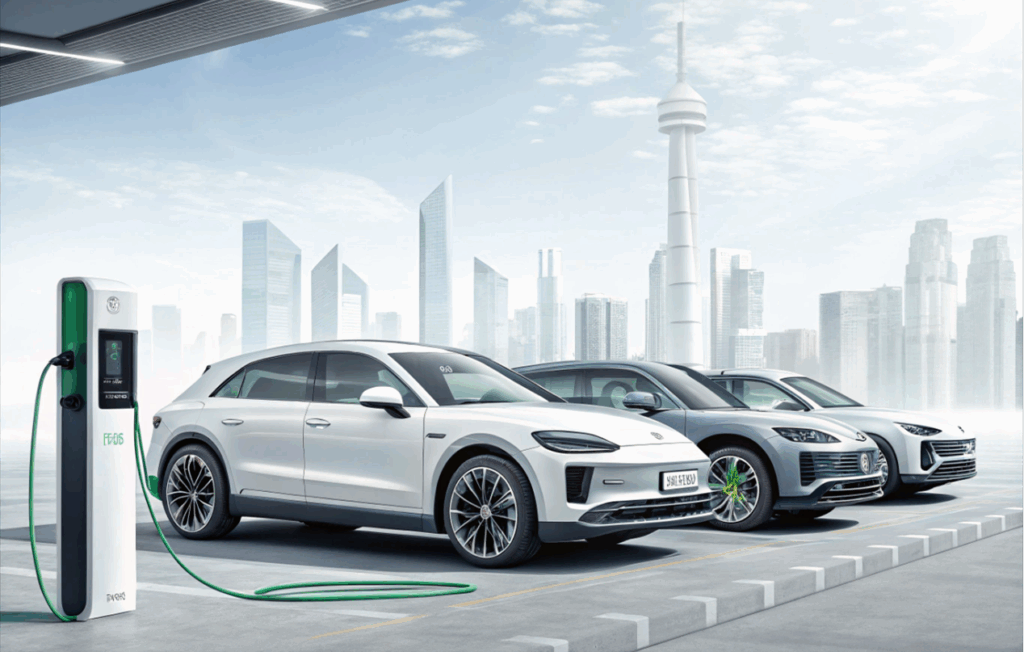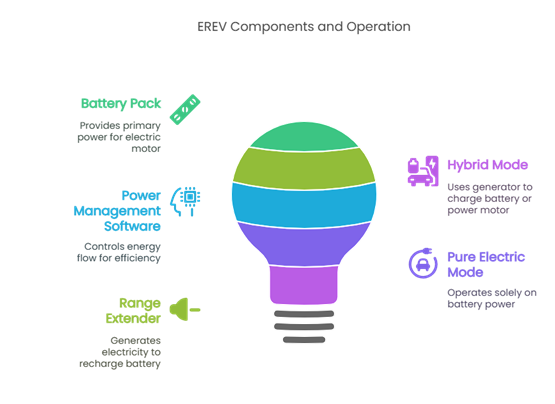What Are Extended Range Electric Vehicles(EREVs)? Things You Don’t Know
What if an electric car could eliminate “range anxiety” without fully sacrificing the thrill of emission-free driving? Extended Range Electric Vehicles (EREVs) offer a unique approach to electric mobility: they run primarily on battery power like an EV, but also include a small fuel-powered generator to extend their range when needed.
But what is EREV exactly, and how do they really work? Are they just a compromise, or do they offer the best of both worlds? Let’s take a closer look at what makes EREVs different—and why they might be a practical choice for drivers not ready for a fully electric car.

How EREVs Work: The Hidden Tech Behind the Range
Key Components of Extended-Range Electric Vehicles
- Battery Pack
In an Extended Range Electric Vehicle, the battery pack plays a vital role—it’s the main source of power for the electric motor. These battery packs typically hold between 10 to 20 kWh of energy[1], which is more than what you’d find in regular hybrids or even many plug-in hybrids. That extra capacity means EREVs can drive longer distances using only electricity.
- Compact Gasoline/Diesel Generator(Range Extender)
The compact generator, or a range extender (REX) steps in to produce electricity when the main battery runs low, helping recharge the battery and allowing the vehicle to keep going farther.
These generators are built to be as light and space-efficient as possible, so they don’t add too much weight or take up too much room in the vehicle.
- Smart Power Management Software
Another important part of an Extended Range Electric Vehicle isn’t something you can see—it’s the power management software. Think of it as the vehicle’s brain.
It carefully controls how energy flows between the battery, the generator, the electric motor, and other systems. By doing so, it helps the vehicle run smoothly, use energy more efficiently, and deliver better overall performance.
How EREVs Work
EREV operation revolves around two distinct energy delivery strategies:
Pure Electric Mode
When battery state of charge remains above predetermined thresholds, the vehicle operates exclusively on stored electrical energy. The electric motor draws power directly from the battery pack, delivering zero tailpipe emissions and near-silent operation.
Hybrid Mode
As battery SOC drops below critical levels, the ICE generator automatically activates. Do extended-range electric vehicles use gas? Rather than directly powering the wheels, the generator either:
- Charges the battery pack for later electric motor use
- Supplies electricity directly to the motor while simultaneously charging the battery

Pros & Cons of Extended Range Electric Vehicles
Pros:
Eliminate Range Anxiety: One of the biggest perks of Extended Range Electric Vehicles is how they help ease range anxiety—that common worry about running out of battery before finding a place to charge. Thanks to their built-in range extender, Extended Range EVs have a backup energy source on board, so drivers can take longer trips without the stress of getting stranded.
Lower Emissions: When it comes to emissions, EREVs have another edge. They produce fewer emissions than traditional gas-powered cars—especially when mainly running in electric mode. And when the range extender does kick in, it often runs more efficiently than a regular engine.
Cost Savings: Because EREVs don’t rely entirely on their battery, they can use smaller battery packs than fully electric vehicles (BEVs) built for long distances. This can help lower the upfront cost while still offering similar total driving range.
Cons:
Complex Maintenance: While EREVs with an EV range extender offer added flexibility, they also come with extra maintenance needs. Just like traditional gasoline vehicles, the engine requires regular services like oil changes and filter replacements. This adds to the maintenance compared to BEVs, which have fewer moving parts and generally require less upkeep[2].
Lower Energy Efficiency: In EREVs, the process of turning fuel into electricity and then using that power to drive the wheels involves several steps. Each of these steps reduces overall efficiency, making the range extender less energy-efficient than simply using battery power, like in BEVs[3].
Limited Practical Value: For drivers who mostly take short trips and have easy access to charging stations, the range extender might not be fully necessary. In such cases, the added weight, complexity, and cost of the range extender may not provide much benefit.

Learn More About EREVs at Mobility Tech Asia 2025
If you’re passionate about EREVs or the future of clean transportation, Mobility Tech Asia 2025 is an unmissable event. Taking place from July 15–17, 2025, at AsiaWorld-Expo in Hong Kong, MTA brings together over 350 exhibitors and thousands of professionals from across Asia and beyond. The event showcases cutting-edge innovations in electric and hybrid vehicles, hydrogen technologies, e-mobility charging, and more.
Don’t miss this opportunity to be at the forefront of Asia’s new energy mobility revolution. Register now and be part of shaping the future of sustainable transportation!
Reference
- Extended range hybrids – combining ecology and efficiency. Available at: https://knaufautomotive.com/extended-range-hybrids-combining-ecology-and-efficiency/ (Accessed: 23th, April)
- What are range extender cars? Available at: https://www.electrifying.com/blog/knowledge-hub/what-are-range-extender-cars (Accessed: 23th, April)
- What is an extended-range electric vehicle? Advantages and disadvantages of extended-range new energy vehicles Available at: https://www.xindamotor.com/knowledge/what-is-an-extended-range-electric-vehicle-advantages-and-disadvantages-of-extended-range-new-energy-vehicles/ (Accessed: 23th, April)

